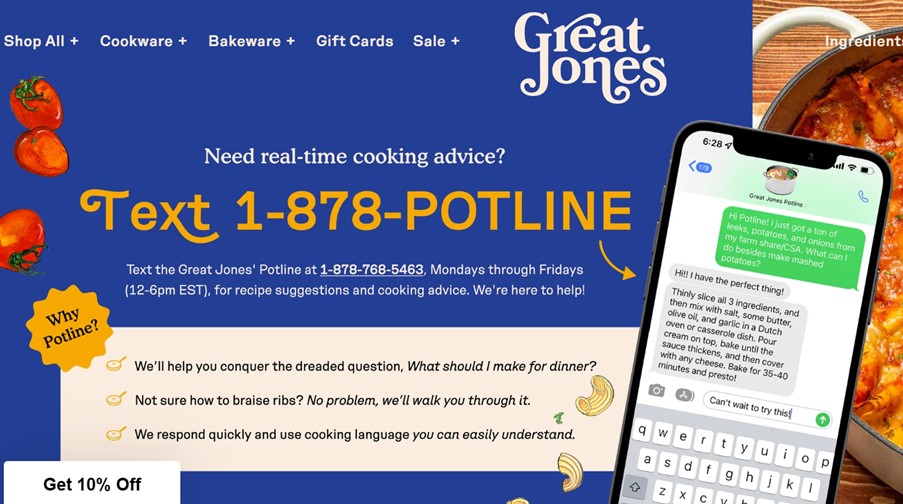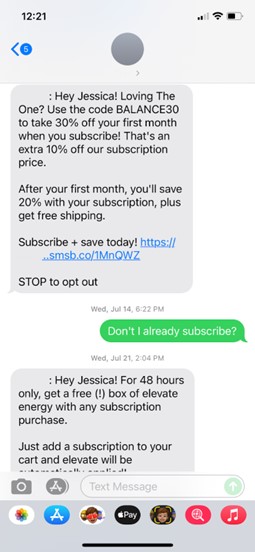How to Maximise SMS Marketing ROI

SMS marketing is tricky because… it actually works. 🤯
98% of people open the message, and a lot of them open it within minutes after it arrives in their inbox.
Overall, that’s a good thing. But, on the flip side, this channel is important and intimate, which means that people are easily irritated if your message is spammy or irrelevant.
They’ll open the message, but they also won’t hesitate to opt-out if you annoy them.
Hence, the tricky part: you don’t have a lot of room for error in those 160-ish characters you’re working with.
You gotta make them count if you want a solid SMS marketing ROI.
So, let’s make sure none of your investments are wasted, and you get the best bang for your buck.
6 Ways to Boost Your SMS ROI
With a high open rate and a high opt-out rate, your SMS campaign needs to hit just right from the get-go.
Here are some strategies to help you own that balance beam like a pro gymnast and make your audience glad they opened the message.
1. Get More High-Quality Opt-Ins
First things first: you legally need to collect opt-ins before you start an SMS campaign to avoid paying expensive fines for sending unsolicited texts.
With that said, opt-ins aren’t the be-all and end-all green light you need to start texting leads.
Yes, more texts sent to more people = boosted ROI.
However, if you don’t filter your audience, your messages could end up incorrectly formatted or undelivered because the person changed phone companies or moved out of your reach.
You don’t want to be spammy or send texts to irrelevant leads who aren’t using the service anymore – you’ll waste resources and even turn off potential customers.
Here’s how to qualify leads better:
- Let them know they can text you – create a simple but specific opt-in greeting they can send you like “book appointment” or “track my order”
- Provide codes or links they can use to unsubscribe like “STOP”
- Tap into your existing channels, like email newsletters, to reach people who are already interested and following you
- Make it clear what people are getting into when they opt in by specifying what type of messages they can receive, and how often they’ll receive them
You can get creative with your campaign and let people come to you. We love this approach from Great Jones, a cookware brand, with a “Potline” where users can ask for recipe ideas:
It’s a clever way to stand out and generate brand awareness. 🍳
After you’ve collected your high-quality opt-ins, don’t send the exact same stuff to all of them. Actually, before you send anything…
2. Segment your audience effectively
SMS is one of the most intimate channels for marketing. You don’t want to overstep any boundaries by blasting out too many generic or irrelevant messages to every single number.
Your SMS marketing campaign shouldn’t – we repeat – should NOT look like this:
It’s confusing to the user because they keep getting the “subscribe now” messages, which doesn’t make any sense if they’re already subscribed.
In this example, the user’s response didn’t get through, either – the texts are clearly part of a strict sequence with no room for interaction and feedback, so it feels like talking to a brick wall. No thanks.
To avoid users slamming the door on you minutes after they’ve walked in, you have to treat them like VIPs and send them timely, tailored, and personalised texts.
Including the customers’ names, location-based suggestions, and purchase history into your consideration makes a world of difference – as long as you’re not being invasive, of course.
Segmentation will give you the key.
What kind of data can you use to segment an audience?
Demographics are commonplace to begin with, but there are other things that influence people’s choices and preferences as well.
Segment by engaged vs. unengaged leads, new leads, the most loyal customers, etc.
You can do this manually, but it quickly gets tedious and life draining.
If you have access to it via your provider or integration with a CRM, automated lead and customer segmentation is a game-changer for your efficiency – not to mention the battle to stay awake at work.
Tailor the sort of content you send to each group. For example:
| Segment | SMS message element examples |
| New leads |
|
| Engaged repeat customers |
|
Remember that these groups won’t be permanent.
It’s totally normal to move leads from one segment to another (say, new leads that become engaged or loyal customers) based on their lifecycle and the analytics you get from your interactions.
To quickly sum it up:
- Segment by more than location and demographics
- Get to know your audience via surveys and questions
- Tailor your messages to each group
- Measure and optimise performance
- Listen to feedback
- Monitor the users’ journeys and act accordingly
3. A/B Test Your SMS Copy
A/B testing means creating and sending two versions of a message to compare which one performs better for a higher SMS marketing ROI.
It gives you the concrete data you need to know how to get the most out of those 160 characters in an SMS.
You can A/B test based on:
- Keywords and phrases:
- Discount vs. sale
- Coupon vs. discount
- Different terms and tones of voice
- Test the amount of slang and abbreviations
- Different messaging times
- In the morning vs. midday
- On a weekday vs. weekend
- At the beginning vs. end of the month (close to payday)
Feel free to A/B test message sequences, not just individual texts.
Just remember to change one element at a time; otherwise, you won’t know for sure which change made the difference.
These controlled experiments will give you the most precise answers unique to your audience and help you maximise your SMS marketing ROI.
4. Send Texts at the Right Time
We just mentioned some options, but what’s the right time to send texts?
As a rule of thumb, popular SMS messaging times are:
- Midday between 12 and 1 p.m.
- Mornings, starting at 10 a.m.
- Tuesdays and Saturdays
- Paydays (typically the beginning, middle, or end of the month)
Note: Make sure to check country- and state-specific regulations as promotional messages may only be permitted during certain hours. For example, the state of Florida only allows them to be sent between 8 a.m. and 8 p.m. in the consumer’s time zone.
So, should you just pick one of these times, pop it in the calendar, and move on to the next point?
Probably not. Context is everything. You want to find the optimal time based on your company, industry, audience, and other factors that complicate the picture a little bit.
If you’re a travel company with customers across the globe, you need to cater to them across time zones – nobody will be excited to read your message at 5 a.m (and you might face hefty penalties for texting during quiet hours).
So, in addition to popular messaging windows, here are some situational examples of when it would make sense to send an SMS to your audience:
- When they order food, you give them 10% off their next order (like UberEats)
- A reminder 24-48 hours before their scheduled appointment
- When you can use a quick text to substitute lengthy phone conversations and save everyone time – this approach helped a law firm become way more efficient
- When they’ve used your services or purchased products several times, and you want to engage them in a loyalty program by offering a reward for an action, like the chance to apply for a free year with a new credit card or free airline miles for purchases over an X amount
- Whenever you have a relevant offer or update based on the audience segments and time zones
A/B testing can help you discover trends and determine the best times for your unique audience.
In terms of how often you should message them, two to six messages per month is a solid ballpark, so you keep in touch but don’t come across as too aggressive.
But, before you hit send…
5. Cleanse Your Numbers and Routes
SMS hygiene practices need to be done regularly.
Checking your contact list and routes ensures all the right people are getting your messages – you know, the warm leads and customers who opted in and expect to hear from you. What happens when 500 out of 2000 numbers are incorrect or poorly formatted?
It’s like cutting holes in your pockets.
You’re spending your budget to get all those contacts and create and send messages, and you aren’t profiting as much as you could from it because there’s often no one at the other end of the line.
The consequences are both:
- Financial – customers don’t get to interact with or buy from you, so you lose profits while spending money on messages that get lost
- Reputational – leads and customers think you don’t value them or follow up on your promises, so they move on to your competitors
Cleansing your numbers helps you retain customers longer and optimises your SMS marketing ROI.
You can make your list squeaky clean by using an HLR (Home Location Register) lookup service to verify a number’s:
- Registered country
- Networks they relate to
- Original registered network (the one they might have migrated from)
- Mobile country and network codes
- Error indications that could impact deliverability
After the HLR lookup, you know where to reach your audience and which numbers to delete so you get the most out of your budget.
6. Use a Cost-Effective SMS Messaging Provider
How much does SMS marketing cost anyway?
The price of SMS messages can be anywhere between $0.0007 and $0.30 per tex t (depending on the destination and the network).
You’re looking at the higher end if you’re using more MMSs than just SMS messages or are having an agency create and send your messages for you.
At cents per message, SMS is a super affordable marketing channel.
However, you should still carefully consider your provider. Here’s what sets SMS messaging providers apart:
- Reach to different regions: some providers can’t access certain countries limiting your reach
- API integrations: whether you can integrate SMS capability into your CRM or other platforms, which could save you a ton of double work on inputting numbers and copying information across your applications
- Personalised support: having an expert in your corner to guide you makes the whole process so much easier and less stressful
- Rates: the biggest players charge the biggest bucks, but there is a solid SMS messaging provider for any budget
- Mobile number portability: this tool gives you the correct rate for any number you want to contact, even if it’s ported from one operator to another, so you save on costs and potential billing issues
Here are all the things you need to think about for a complete picture about your costs, savings, and SMS marketing ROI when picking a provider:
- Cost of SMS marketing service: in monthly fees or credits
- Channels: some providers can’t access certain countries or networks, and those that can might charge a premium for the service
- Location: the cost of a message varies between different countries
- Number types: short-code, long-code, and toll-free numbers have different uses and prices, with the short-code types typically being the least wallet-friendly
- Losses: money you lose on incorrectly formatted numbers and dead ends that stop you from reaching your audience
- Time spent: learning how to use tools with poor user experience or manually adding numbers without the right integrations can create serious opportunity costs
- Revenue: the increase in profits from higher quality and quantity of SMS messages
Cost-effective beats cheap any day. And then what?
After picking a suitable SMS messaging provider, you need some sort of measuring stick to track your performance.
What Metrics Should I Be Tracking Again?
Are you a seasoned veteran when it comes to measuring marketing ROI but not sure how your usual practices apply to SMS campaigns?
Not to worry.
The general rule applies: you don’t want to waste time measuring every possible metric.
But you have to measure your performance to know for sure how well you’re doing and what you need to improve.
These metrics help you understand your SMS marketing ROI and start optimising your campaigns to reach that sweet spot:
| Metrics to track | How to measure it and what it indicates |
| SMS marketing ROI |
|
| Open rate |
|
| Click-through rate |
|
| Deliverability and bounce rate |
|
| Response rate |
|
| Cost of text messaging provider |
|
And that’s all on SMS marketing ROI and the maths you need to worry about.
What now?
Save Your Budget and Optimise Your SMS Marketing ROI
SMS gives you a fantastic opportunity to meet your audience where they are and facilitate conversations:
- Your audience will almost definitely read what you send them via SMS, which makes SMS message campaigns a make it or break it scenario – you have to use it wisely
- You can improve your campaigns and SMS marketing ROI by qualifying and segmenting leads, A/B testing your copy, and regularly “spring cleaning” your number list to eliminate waste
- To track your progress, keep an eye out for the right metrics, including CTR and response rates, deliverability, and message costs
Are there any questions still holding you back?
Feel free to reach out to Mr Messaging if you want help figuring out whether SMS marketing makes sense for your business and how you should implement it for the best SMS ROI.

